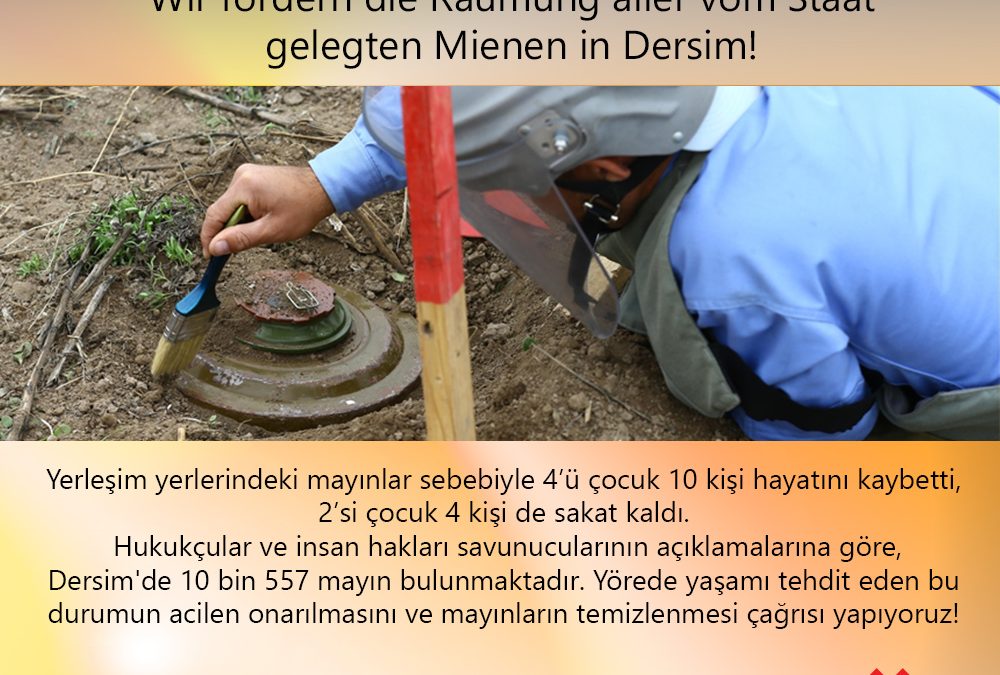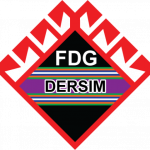

In the video above, you can see a selection of contemporary witnesses
from the project “Dersim 1937-1938 Oral History”
“Dersim 1937-1938 Oral History Project” was launched in 2009 by our federation in cooperation with Clark University in Michigan. The first workshops took place in the premises of the Dersim Kultur Gemeinde Berlin e. V. on 29.11.2009 and 20.12.2009. These workshops took place with scientific support in various locations, including Dersim.
The aim of this project is to secure the testimonies of the last survivors. In order to coordinate the work properly, the FDG has formed the “Dersim 1937-38 Oral History Project Committee” with scientific support. This committee is still active on behalf of the FDG to this day. In order to qualify the project staff, three educational seminars on oral history, interviewing, interview and data backup as well as archiving techniques were held with the support of professors from Clark University, major universities in Turkey and the “Stiftung Denkmal” in Berlin. Under academic guidance, questionnaires were developed analogous to a guideline of the “Shoah Foundation” and a handbook on the history and culture of Dersims was completed for the interviewers.
The 1938 Dersim Genocide Meets the Criteria
of the UN Convention against Genocide

The UN Convention against Genocide
On 9 December 1948, the General Assembly of the United Nations adopted Resolution 260 on the “Convention on the Prevention and Punishment of the Crime of Genocide”, which entered into force on 12 January 1951. According to the Convention, genocide is a crime under international law “condemned by the civilized world.” It was based on UN General Assembly Resolution 180 of 21 November 1947, which stated that “genocide is an international crime requiring national and international responsibility on the part of individuals and states”. Article II of the Convention defines genocide as “one of the following acts, committed with the intent to destroy, in whole or in part, a national, ethnic, racial or religious group as such”.
The offences proven in Dersim 37/38 are:
a) The killing of members of the group
According to official documents, 13,806 people were killed in Dersim in 1937/38 in a speech by the Prime Minister of the Republic of Turkey R. Tayyip Erdogan on 23 November 2011. Of course, it is not possible to determine the actual number. Several investigations and studies carried out show that the actual number is on average three times higher than the one indicated. It should also be noted that the definition of genocide is based on the circumstance of the act and not on the numbers.
b) The infliction of serious physical or mental harm to members of the group
The physical and mental injuries and traumas that continue to affect generations have been documented by academic research, documentaries and the Dersim oral history project 1937/38, which was carried out by the Federation of Dersim Communities in Europe (FDG).
c) The deliberate submission to living conditions aimed at the total or partial physical destruction of the group
The wanton burning of houses, villages, forests and crops can be found in the documents of the Gendarmerie General Command. Moreover, hundreds of testimonies confirm this.
d) The ordering of measures to prevent births
The expulsion of the Dersim people from their ancestral territory, the separation of our society from their roots, culture, faith and language, and the fragmentation of families and the entire society in a vast area in western Turkey was intended to eliminate the Dersim culture. This is documented both in the state archives and in witness reports. The data speak of 11,818 forcibly resettled people. The actual number is likely to be about twice as high.
e) The forcible transfer of children from the group to another group
The policy of Islamization and Turkization of girls by forcibly adopting them from Turkish and Sunni families and forcibly torn from their own families is documented by many studies, documentaries and books. The documentaries “The Lost Girls of Dersim”, “Hay Way Zaman” and “Vanks Children” are worth mentioning here. These documentaries were created by Nezahat and Kazım Gündoğan. A letter entitled “The Education of Dersim Girls and Boys in Boarding Schools” dated June 4, 1937, written by the Minister of the Interior, Şükrü Kaya, on the transport of children, deals with essential aspects of this.

The historical developments of Dersim before 1938
Places of the crime
1. Ağveran
2. Akreg
3. Ali Boğaz
4. Arê Ali Begu
5. Arê Çê Ziyay
6. Aveşi
7. Awge
8. Axpar – Akpınar
9. Baleşer
10. Bırdo Çelemuriye
11. Bırrê Bızeke
12. Bozan
13. Cırnunê Beski
14. Çala Heru
15. Çala Nizamu
16. Çala Qıçkeku (Kırmela Qırğu)
17. Çala Sure
18. Çatê Khalmemi
19. Çayıra (Qerece)
20. Çayırê Khali
21. Çetê Çırrıke (Kilise)
22. Çêwresçıme (Mığara Qopi)
23. Degirmen Bendi
24. Derê Are Ali Begu
25. Derê Arê Çê Derguli
26. Derê Çayıra (Sırtıka)
27. Derê Çırri (Yêrısk)
28. Derê Fındıqu (Oba Ağaê Qıci)
29. Derê Ğezani (Serkemer)
30. Derê Harami
31. Derê İne
32. Derê Khalmemi
33. Derê Khunduji
34. Derê Laçi
35. Derê Meyita (Kilise)
36. Derê Meyitu (Yinê Dızdu)
37. Derê Pulemuriye
38. Derê Qeremuxe
39. Derê Qıci (Ağzonige)
40. Derê Qıli
41. Derê Remedani
42. Derê Roji
43. Derê Sandalu
44. Derê Tağari (Ali Boğaz)
45. Derê Thırsıke
46. Derê Varani (Tosniye)
47. Derê Xori (Thojinge)
48. Derê Xozati
49. Derê Zağgey
50. Derê Zuğuri
51. Desiman
52. Deste
53. Eğniğe
54. Elamqaşi (Dere Nahiyesi)
55. Ergane
56. Gedigê Zêyne (Zini Gediği)
57. Gema Besk
58. Gola Çetu
59. Gola Lerji
60. Golanê Sole
61. Gomê Doy
62. Gomêgari
63. Gozereke (Pilav Dağı)
64. Harşiye
65. Hegao Pil
66. Hırnik (Dere Nah.)
67. Hopıke (Kemerê Çile)
68. Hopıke (Koo Sıpe)
69. Jiara Paçkıne
70. Karvan
71. Katır Çukuru
72. Kemerê Arey (Halvoriye)
73. Kemerê Çilê
74. Kemero Phan (Kilise)
75. Kevırkan
76. Kewlê Kımsori
77. Khaniya Derıke
78. Kırniga Khali
79. Koo Sur
80. Korta Heru
81. Kosoğlu Deresi
82. Koo Sıpe – Beyaz Dağ /Ko
83. Koo Sıpe-Çayıra Phıti
84. Koo Sıpe-Çala pey
85. Lazvan
86. Marçık
87. Masumo Pak (Dewa Pile)
88. Mazgirt Merkez
89. Merga Çeqere
90. Merga Kemi
91. Mergê Kesisu
92. Merxo
93. Mezra Çê Ağay
94. Mezra Sure
95. Muxewndi
96. Pıskeğ
97. Pulê Fate
98. Qelxeru
99. Qereğlan
100. Qereqol (Yêrısk)
101. Qurçu
102. Raa Thonjige (Pardiye)
103. Roşnage
104. Saldağ
105. Samoşiye (Qerğac)
106. Serkêsur (Bargini)
107. Sinan
108. Sorpiyan
109. Soxariye
110. Şine
111. Şorda
112. Taçkirege
113. Tanerê Lolu
114. Tanero Corên
115. Tasniye
116. Tevnasi
117. Textxel
118. Varseliye
119. Vıroz
120. Viyaleke (Tornoba)
121. Vonkê Qerebaşi
122. Warê Xurxuriki (Mırcan)
123. Welağanê İne
124. Xotara Çê Abaşi
125. Xuxtaru
126. Zankirege
127. Zêrza Axpano
128. Zini Gediği

TERTELE picture gallery

Places of the crime

Laç Tal (Latsch Tal), Qemeri Heseni Cave, 1938
People have been hiding at this altitude. Here the people were shot by a task force.

Bones of the shot dead
The same cave with the bones of the shot. They are commemorated with candles.
Laç Tal (Latsch Tal), Qemeri Heseni mağarası, 2014
Halvoriye

Dersimer are brought to the place of execution.
From the album of the commander who led the military action in this place. The place was called Kemerê Arey in the album. However, it is the place Halvoriye.

Text on the back of the photo
Large military operation on 14 August 938 (note:1938) in Dersim, village Halvoriye. The 217 outstanding Kurds (note: the Kırmanc/ Alevis were called Kurds at that time) from the village of Halvoriye are taken to the place of execution.
Source: Cemal Taş

One of the most famous crime spots: Halvoriye
To save bullets, the defenseless people were stabbed with bayonets and then pushed down the steep and high cliffs, some of them alive.
This photo is from 2014

Interview about the Zaza language
Interview with the Iranologist Prof. Dr. Ludwig Paul about the Zaza language Dr. Zeynep ARSLAN Prof. Dr. Paul, what is the position of Zazaki in the circle of Iranian languages? Zazaki is an Indo-European language. The Indo-European languages are divided into many...

Berlin TERTELE Commemoration 4 May 2018
Berlin TERTELE Commemorative Presentation May 4, 2018 In this presentation you will find posters of our Tertele commemoration events that have taken place since the founding of our congregation in Berlin.
Rally Sivas 30th Anniversary
Madımak da yaşamını kaybeden canlarımızı Berlin ́de 30. yılında yoğun bir katılımla andık.*"Dewleta Tırki ver ra ve nıka zalıme biye, barbare biye, gonewere biye. Pêê qul weşnayena Sevaji ‘93ine de Dewleta Tırki biye.Qırkerdena Koçgiri’ 21ine de, Tertelê Dêsım ‘38i...
Commemorative rally – Dersim Denkmal
We held our commemoration event on 13.11.2021 on Oranienplatz. In the beginning, Pir Seydali Cicek and Pastor Dorthe Gülzow held a devotional ceremony in Zaza and German. Afterwards, the following people made contributions: Our Chairperson Müslüm Karadas, Chairman of...

Who is allowed to remember?
Who is allowed to remember? Dear Ladies and Gentlemen, Dear Friends of Dersim,It is with particular pleasure that I welcome you on behalf of the Federation of Dersim Communities in Europe. My name is Kemal Karabulut, and I chair this federation and am a member of the...

DÜZGÜN BABA İNANÇ VE KÜLTÜR ETKİNLĞİ
Sevgili Dersimliler ve Dersim Dostları, 19. DÜZGÜN BABA İNANÇ VE KÜLTÜR ETKİNLĞINE Hoş geldinizBiz ağırlıklı olarak Avrupa'da çalışmalar yürüten ve yüzü Dersim'e dönük bir kurumuz. 80 ́ li yılların ortalarına doğru örgütlenmeye başlayan Diaspora Dersimlilerinin, 2006...

Dersim 1937-38 Oral History Project (DSTP) Duisburg 6.12.2024
Dersim 1937-38 Oral History Project (DSTP) The reasons for the need for Dersim organizations in Turkey and Europe were not only the loss of the mother tongue, faith and other cultural values and the endangerment of Dersim's geography. There was another factor that was...

”Dersim Tertelesi” Berlin Parlamentosu’nda
Avrupa Dersim Dernekleri Federasyonu, Sol Parti ile birlikte 1938'de gerçekleşen ve “” Dersim Tertelesi “” olarak adlandırılan olayları, çok sayıda bilim adamı ve politikacının katılımı ile 17 Mayıs Salı günü Berlin Eyalet Parlamentosu'nda tartışacak ''Dersim...

Happy International Mother Language Day!
Happy International Mother Language Day! Bendê verê zonê ma Zazaki/Kirmanci pero wedariyê! Ewro 21ê guciga, Zonê ma tengie dero! Roza zonê ma u piyu ́ne Dina sa bo! Zonê ma beno vind! Zon ke bi vind Qom ki beno vind! ................................. Our language is...

Dersim’de 10 bin 557 mayın bulunmaktadır.
Dersim'de 10 bin 557 mayın bulunmaktadır. Dersim'de 10 bin mayın: 10 yılda 10 kişi öldü. Dersim'de son 10 yılda 4'ü çocuk 10 kişi mayın nedeniyle hayatını kaybetti. Hukukçular ve insan hakları savunucularının açıklamalarına göre, Dersim'de bulunan 10 bin 557 mayının...
FDG
You have a better translation?
Help us to make the site available in German, Turkish, English and Zaza. Send us an email with your suggestions for improvement.
